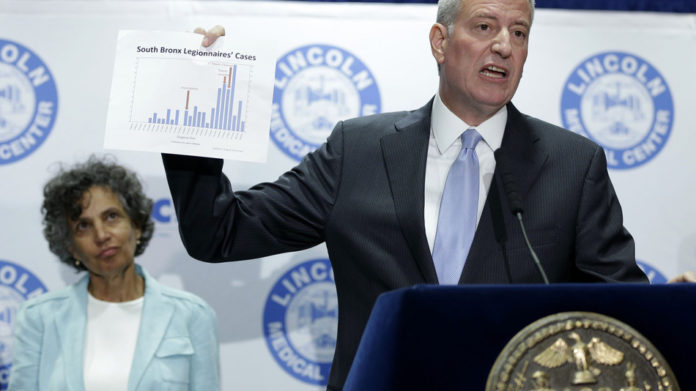What you need to know about the Legionnaire’s disease outbreak in NYC

The number of cases of Legionnaire’s disease, a form of bacterial pneumonia, in New York City again rose on Tuesday — to a total of 86. Seven people have so far died from the disease, according to Mayor Bill de Blasio’s office.
The cases are all clustered in the South Bronx, and local officials have called on the city to tighten regulations on water-cooling towers, where the illness is thought to have originated. Legionella bacteria has been found in five water towers in the area.
According to the New York Times, the number of cases of Legionnaires has tripled in the last decade in the city, with many concentrated in high-poverty areas.
Bronx borough president Ruben Diaz Jr. commended the city for quickly responding to the outbreak and decontaminating the five cooling towers that were found to be polluted, but called on the city to put measures in place to prevent this from happening again.
“Why, instead of doing a good job responding, don’t we do a good job proactively inspecting?” asked Diaz, speaking in a town hall meeting on Monday night to address concerns about the disease.
The city doesn’t currently have measures in place to regularly inspect cooling towers, and leaves it up to building owners to maintain them.
De Blasio has said there is legislation in the pipeline to address the issue.
Soon, new legislation will require buildings to take immediate action if Legionella is detected and impose penalties for failure to comply.
— Bill de Blasio (@BilldeBlasio) August 4, 2015
What is Legionnaire’s disease
The disease, a form of bacterial pneumonia, was first discovered after an outbreak at an American Legion convention in Philadelphia in 1976 when many people became sick with respiratory illness.
The disease cannot be passed from person to person and is spread chiefly by a person breathing in small droplets of contaminated water, according to the CDC.
Legionella bacteria can multiply quickly in artificial water supply systems like air conditioning systems. Large buildings are more vulnerable to contamination because of their complex water supply systems.
The fatality rate is between 5 and 30%. Smokers, older people and those with chronic respiratory problems or weakened immune systems are particularly vulnerable.
According to city officials, everyone who has died of the disease thus far was an older adult with underlying medical problems.
The New York Department of Health and Mental Hygiene is going to continue to monitor for new cases and is carrying out an epidemiological investigation. The department is working closely with local hospitals to do outreach to vulnerable populations.
The water cooler connection
Legionella bacteria thrives in warm water and become especially dangerous when the water is turned into a mist that can be inhaled. In the case of New York City’s outbreak, the infected people may have simply been walking by on the street when they inhaled mist that appears to have come from the cooling towers.
Investigators are still trying to determine which, if any, of the five cooling towers that tested positive for the bacteria are directly linked to the illnesses — The presence of the bacteria doesn’t necessarily mean the equipment infected anyone.
The South Bronx neighborhood may have been particularly vulnerable for many reasons, but researchers have found the disease is most often found in impoverished areas.
According to a 2014 study published on the disease published in the Emerging Infectious Diseases medical journal, “findings suggest systemic differences in the risk for acquiring Legionella infection based on neighborhood-level poverty.”
The study suggested that public health policy makers need to step in.
“If environmental issues in high-poverty neighborhoods contribute to the disparity, greater effort may be warranted, for example, on the upkeep of cooling towers and water systems in the buildings in these areas,” reads the study. “Socioeconomic and occupational factors represent important and understudied potential sources of exposure among community-acquired cases of legionellosis.”
The five cooling towers involved in the New York investigation have all been decontaminated, and lawmakers are hurriedly crafting legislation they say could help prevent another such outbreak.
Building owners would be required to register the location of cooling towers with the city. There will also be a schedule of mandatory inspections, plus rules mandating a prompt disinfection if bacteria are found.
The New York Department of Health encourages those with respiratory symptoms such as cough, chills, fever and muscle aches to seek medical attention.
Some information from the Associated Press.
Have something to add to this story? Share it in the comments.
